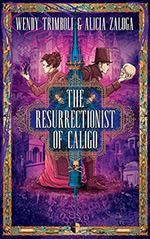
![]() Arifel
Arifel
1/2/2020
![]()
Enemies to lovers Victorian medical mayhem
Sibylla is a princess, in a world where only the elite (including the royal family) are born with magical gifts, leading to jealously guarded bloodlines and inbreeding within the nobility. Roger Weathersby is a resurrectionist and aspiring doctor, trying to fund informal medical studies by providing the cadavers which medical professors need to dissect and learn from. Despite the differences in their background, almost insurmountable in such a status-driven society, Sibylla and Roger are former friends and had a brief romantic history in their teenage years, but that's very much behind them - until Sibylla decides to bring it up in a letter, and then Roger is arrested for a series of murders he didn't commit and the only way out of being hanged for them is to submit to an ancient form of enslavement which will give Sybil complete control of him for the rest of his life. If this seems like a good basis for a slow burn romance, you're right - but Resurrectionist of Caligo isn't delivering this in full. Instead, this is a story about the two protagonists coming together over the injustices and prejudices of their highly stratified society, and attempting to leverage their limited agency to bring down a killer who the rest of the world seems uninterested in bringing to justice.
Resurrectionist of Caligo moves in two very different worlds: the intersection of the working class and academia which Roger inhabits, needed by but never accepted by members of the latter; and Sibylla's repressed court existence, dictated by her Grandmother the Queen. The range of characters in the former turn out to be significantly more interesting and sympathetic than the latter (Sibylla has three "Cousin Eds" who I didn't even try to learn to tell the difference between) and Roger's story also escalates much more quickly, with far more immediate consequences, than Sibylla's, meaning for much of the book it was his sections I was most engaged by. In contrast, much of what engages Sibylla: her return from several years of enforced seclusion after refusing an arranged marriage to her cousin, and her designs on making a mark in diplomacy with a neighbouring-closed off kingdom - are issues that feel only tangentially related to the main plot as its presented to us. This is thoroughly driven home by the scenes in which Sibylla engages with the sections of society which literally pray to her (as a sort of fertility goddess, which she has mixed feelings about) and finds out about the Strangler through a plea for her intervention; she resolves to do something about it but is soon blown off course by external events and ends up more engaged in her Grandmother the Queen's marriage schemes instead.
http://www.nerds-feather.com/2019/10/microreview-book-resurrectionist-of.html